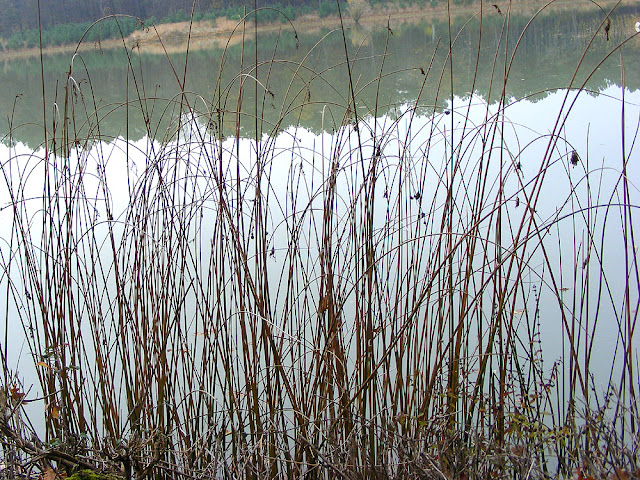Once upon a time there would have been a rush weaver in nearly every village, and the plant they used would have been abundant on the edges of rivers and étangs (dams) where the water was shallow and still. Now the plant, true bulrush Schoenoplectus lacustris, is sufficiently rare that if you have it growing on a site you can have it declared a Zone Naturelle d'Interet Ecologique, Floristique et Faunistique (ZNIEFF). It is easy to cultivate, but rush products went out of fashion and the skills to process the plant were lost. Nowadays it is making a comeback, but as an aquatic plant used in environments that need stabilising.
True Bulrush at the Etang du Louroux, a great purpose built pisciculture dam, hand dug in the Middle Ages, so this is a scene that has barely changed for eight hundred years.
In French bulrush is known as Jonc des chaisiers ('chairmakers' rush') because it was used to weave the seats of chairs. And it was used by coopers to bind barrels before the iron hoops were put on, hence it's alternative French name of Jonc des tonneliers. Up until the 1960s, rush harvesting was a quite lucrative side hustle for farmers with marshy land (particularly in the Marais Poitevin). These days though, 'rush' seats are made from twisted paper fibre or seagrass.
Rush matting on the floor, specially made in the 16th century style for the garderobe of Chateau of Azay le Rideau by an English rush weaver experienced in historical reproductions.
Some years ago curators at the Chateau of Azay le Rideau recreated Philippe Lesbahy's 16th century bedroom and included rush matting.
Taking their cue from a well known portrait of a royal mistress in the bath, hand made rush matting was commissioned from an English artisan who is one of the few remaining professional rushworkers in Western Europe. The painting shows the walls of the room the woman sits in as lined with rush matting. The chateau sadly does not have the original painting on display -- that's in Washington -- but it does have a 19th century version that you can get extremely close to and scrutinise for details.The actual braiding pattern for the matting is based on a fragment found at Hampton Court Palace.
Rush matting was a relatively cheap and easily available alternative to expensive carpets and tapestries. The purpose of all of these soft furnishings was to prevent cold radiating from the stone walls and to deaden sound in large echoing rooms. Housekeeping was easy -- dirt mostly just falls through, but it is a good idea to periodically mist with water to keep the rush in good condition and pleasantly aromatic.
True Bulrush in a ZNIEFF at Chambon.






No comments:
Post a Comment